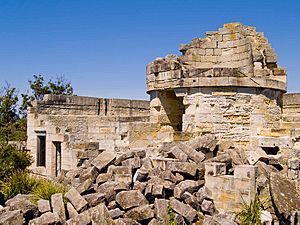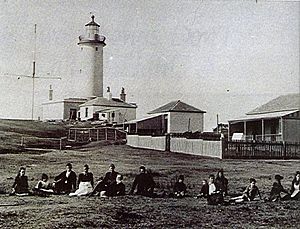Cape St George Lighthouse facts for kids
 |
|
| Ruins of Cape St George Lighthouse, 2008 | |
|
|
|
| Location | Jervis Bay Village, Jervis Bay Territory, Australia |
|---|---|
| Coordinates | 35°9′7″S 150°45′41″E / 35.15194°S 150.76139°E |
| Year first constructed | 1860 |
| Deactivated | 1889 |
| Foundation | Sydney sandstone |
| Construction | Limestone tower |
| Tower shape | Cylindrical tower |
| ARLHS number | AUS-048 |
The Cape St George Lighthouse was a lighthouse that once stood near Jervis Bay Village, Jervis Bay Territory in Australia. It was built in 1860 and helped guide ships until 1889.
This lighthouse was located about 3 kilometers (1.9 miles) south of the entrance to Jervis Bay. Sadly, the tower was destroyed between 1917 and 1922. This was done to prevent sailors from getting confused by two lighthouses in the same area during the day. Today, only the ruins of the lighthouse remain. These ruins are now protected and listed on the Commonwealth Heritage List.
Contents
History of the Lighthouse
The idea to build a lighthouse in this area came up in 1856. Even though the Pilots Board, which was in charge of such things, wasn't asked, money was set aside, and a building contract was approved.
Problems Before Building
Right from the start, there were arguments about where the lighthouse should be. Many people questioned if ships approaching from the north or south would be able to see it. Maps showed the proposed site and the actual site were about five miles apart!
When the Pilots Board finally checked the location, they found the maps were very wrong. They couldn't even tell if the spots marked on the map actually existed. They also worried if the lighthouse would be visible from where ships needed to see it. Despite these problems and disagreements, the lighthouse officially opened on October 1, 1860.
Why the Lighthouse Didn't Work Well
It turned out the light from the lighthouse couldn't be seen from the northern entrance to Jervis Bay. It was also barely visible from the southern entrance. When the Pilots Board inspected it, they found even more issues. The builder had placed the lighthouse about 2.5 miles (4 kilometers) north of where it was supposed to be. This was because it was closer to the stone quarry he was using.
Later, the Government of New South Wales set up a special committee to look into these mistakes. The committee found that the Pilots Board had been very careless. They had approved the location without checking it first and had trusted inaccurate maps. The committee concluded that "very grave errors" were made in building this lighthouse.
The Lighthouse's End
Between 1864 and 1893, 23 ships crashed on the South Coast of New South Wales near Jervis Bay. This showed how badly a proper lighthouse was needed. The Cape St George Lighthouse was eventually replaced in 1899 by the Point Perpendicular Light. This new lighthouse was in a much better spot. The light from the old Cape St George Lighthouse was taken out and later used in the Crookhaven Heads Light, which was built in 1904.
After the new lighthouse was built, people worried that having two tall towers so close together would confuse sailors during the day, especially in bad weather. So, between 1917 and 1922, the Cape St George Lighthouse was used for target practice by the Royal Australian Navy and was destroyed.
Why the Ruins Are Important (Heritage Listing)
On June 22, 2004, the ruins of the lighthouse were added to the Commonwealth Heritage List. This means they are protected because they are historically important.
The ruins are significant for several reasons:
- They show how navigation aids were developed along Australia's coast.
- The lighthouse's construction was part of the first agreement between Australian colonies about building lighthouses.
- Even though it didn't work for long, the ruins help us understand an important time in Australia's history, especially because it was built in the wrong place.
- The ruins are located on a high cliff, which makes them beautiful to look at. The fact that the lighthouse was built incorrectly and later destroyed adds to its unique history.
- The ruins also show where the first settlement on the Bherarerre Peninsula was located.
The lighthouse ruins were also listed on the (now closed) Register of the National Estate on October 21, 1980.
Who Looks After the Site
The Wreck Bay Aboriginal Community and the Department of the Environment, Water, Heritage and the Arts manage the site. It is part of the Booderee National Park.
Visiting the Ruins
The park service has worked to keep the ruins from falling apart further. You can find the ruins off Stony Creek Road, which is a gravel road in the park. It's about 16 kilometers (10 miles) southeast of Jervis Bay Village. There's parking nearby, and you can walk around the grounds, but you can't go inside the ruins themselves.
See also
 In Spanish: Faro de Cabo St George para niños
In Spanish: Faro de Cabo St George para niños



